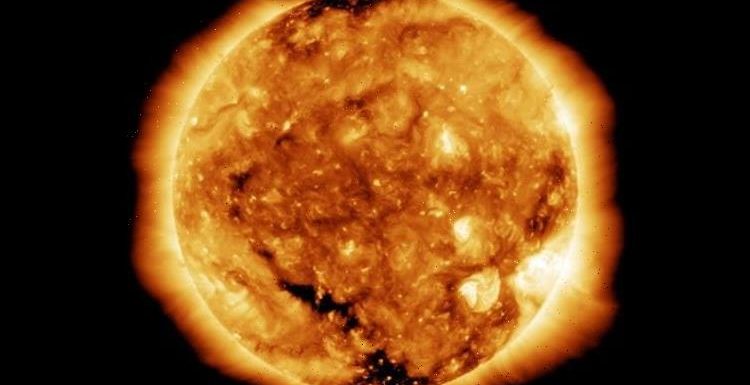
Earth’s ‘magnetic song’ captured during solar storm
We use your sign-up to provide content in ways you’ve consented to and to improve our understanding of you. This may include adverts from us and 3rd parties based on our understanding. You can unsubscribe at any time. More info
A stream of solar wind is possibly headed our way, carrying with it charged particles from the upper reaches of the Sun’s atmosphere. The “fast-moving” moving stream was detected after a giant hole appeared in the star’s southern hemisphere. These so-called coronal holes are regions in the Sun’s corona (upper atmosphere) where the plasma is considerably cooler and less dense than the surrounding areas.
According to the US space agency NASA, solar winds typically reach speeds between one and two million miles per hour.
And the stream possibly headed our way is expected to strike the planet by Thursday, according to the astronomers behind SpaceWeather.com.
If this happens, the interactions between Earth’s magnetic field and material from the Sun could trigger an array of solar activity and geomagnetic unrest (solar storms).
Space Weather said on Tuesday: “A stream of fast-moving solar wind could hit Earth’s magnetic field on December 16.


“The gaseous material is flowing from a southern hole in the Sun’s atmosphere.
“Polar geomagnetic unrest and Arctic auroras are expected when the wind arrives.”
Depending on their severity, solar storms can have a wide array of impacts on the planet.
According to the US Space Weather Center (SWPC), solar storms are ranked on a scale of “G1 Minor” to “G5 Extreme”, with the latter being the most dangerous.
Solar storm: NASA captures the moment a sunspot 'explodes'
Minor storms can result in “weak power grid fluctuations” have a “minor impact on satellite operations”.
Weak storms are also known to confuse some migratory animals and can produce auroras at high latitudes.
But as their severity increases, so does their potential impact on terrestrial and orbital technology.
A G3 Strong storm, for example, can lead to surface charging on satellites and “drag may increase on low-Earth orbit” spacecraft.


At the far end of the scale, extreme storms can cause entire power grids to collapse and “transformers may experience damage”.
Furthermore, satellite degradation is degraded and low-frequency radio signals can be blocked for hours at a time.
The SWPC said: “During storms, the currents in the ionosphere, as well as the energetic particles that precipitate into the ionosphere add energy in the form of heat that can increase the density and distribution of density in the upper atmosphere, causing extra drag on satellites in low-earth orbit.
“The local heating also creates strong horizontal variations in the ionospheric density that can modify the path of radio signals and create errors in the positioning information provided by GPS.
“While the storms create beautiful aurora, they also can disrupt navigation systems such as the Global Navigation Satellite System (GNSS) and create harmful geomagnetic induced currents (GICs) in the power grid and pipelines.”
At present, the SWPC does not expect any noticeable geomagnetic unrest around the planet, according to its three-day forecast.
The SWPC said on Tuesday morning: “No G1 (Minor) or greater geomagnetic storms are expected.
“No significant transient or recurrent solar wind features are forecast.”
Source: Read Full Article